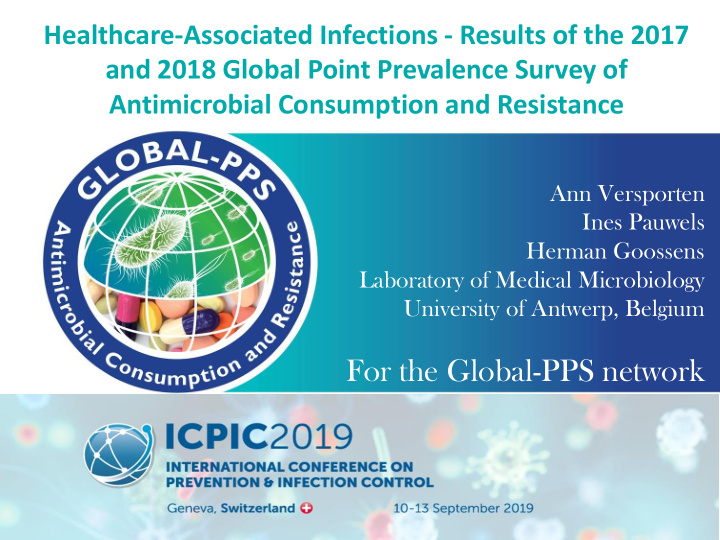



Healthcare-Associated Infections - Results of the 2017 and 2018 Global Point Prevalence Survey of Antimicrobial Consumption and Resistance Ann Versporten Ines Pauwels Herman Goossens Laboratory of Medical Microbiology University of Antwerp, Belgium For the Global-PPS network
DISCLOSURES bioMérieux is the sole private sponsor of the Global Point Prevalence Survey. The Global-PPS is also funded by a personal Methusalem grant to Herman Goossens of the Flemish government. The funder has NO role in study design, data collection, data analysis, data interpretation, or writing the report. Data are strictly confidential and stored anonymously at the coordinating centre of the University of Antwerp. ”
Global-PPS surveillance tool in a nutshell Based on ESAC-PPS Since 2015 : Any hospital admitting inpatients is welcome to participate On a voluntary basis Implementing a uniform standardized methodology Offers a simple web-based tool : quality assurance, data validation process and feedback reporting Hospital build up own database, they remain owner of own data Since 2018 three survey periods/year
Global-PPS purpose Monitor rates of antimicrobial prescribing in hospitalized adults, children and neonates. Determine the variation in drug, dose and indications of antimicrobial prescribing across continents. Identify targets to improve quality of antimicrobial prescribing Identify targets to prevent Health-care Associated Infections (HAI) Help designing stewardship interventions to promote prudent antimicrobial use and improve patient health Assess effectiveness of interventions through repeated PPS 4 4
Global-PPS method in a nutshell • Point- Prevalence “snapshot at a particular time” • All wards of the hospital are included “once” • Denominator collected at ward level N patients admitted N available beds • Numerator data collected for those patients on at least one antimicrobial Patient data (age, sex, gender, weight) Antimicrobial prescription data (agent, dose, diagnosis, indication, set of quality indicators) Microbiology data (targeted versus empiric use, AMR data) • Data collection on paper forms • Web-based data entry, verification, validation and reporting with the help of the Global-PPS tool • See protocol available at www.global-pps.com/documents/ (several languages)
Degree of participation in 2017-2018 EU: 20C;179H NA: 2C;65H Asia: 17C;173H LA: 10C;90H Africa: 8C;116H Australia;9H N = 58 C (countries) N = 632 H (hospital participations) N = 540 unique hospitals
Antimicrobial prevalence (%) HAI prevalence (%) worldwide worldwide Adjusted for hospital Adjusted for hospital and ward type and ward type Crude prevalence Crude prevalence 2011-2012 ECDC-PPS : Mean HAI prevalence 2011-2012 ECDC-PPS : Mean AMU prevalence Europe = 6.0% (95% CI: 5.7-6.3%) Europe = 35.0% (country range: 21.4-54.7%)
Which systemic antibacterials (ATC J01) are used for a HAI worldwide Mainly vancomycin (91%) Mainly ciprofloxacin (56.3%) Mainly piptazo (65.2%)
Antibiotic quality indicators for HAI by region Prescribed Stop/review Targeted Targeted Reason Guidelines according Targeted date in treatment treatment in notes missing to treatment notes PNEU UTI guidelines Africa 65.4% 20.4% 33.4% 77.2% 19.3% 22.7% 44.9% Asia 84.0% 42.2% 14.8% 83.8% 32.7% 26.5% 47.2% Australia 68.9% 23.6% 16.2% 79.8% / / / Europe 84.7% 40.4% 13.0% 81.6% 40.0% 34.5% 52.2% North AM 94.7% 56.8% 20.1% 83.3% 41.4% 23.2% 64.8% South AM 91.9% 74.4% 13.9% 79.0% 36.9% 31.2% 63.6% TOTAL 85.1% 42.2% 15.9% 81.8% 35.0% 28.3% 54.5%
Discussion • High HAI prevalence rates (South AM) • High broad spectrum prescribing for HAI carbapenems (South AM, Africa, Asia) • Need for invest in Latin America ! • Hospitals use this tool to enhance quality of antibiotic prescribing Introduce simple antibiotic quality indicators as part of antibiotic stewardship programs Develop local prescribing guidelines Measure the impact of interventions through repeated PPS Change practice (sustainability)
New optional HAI module as of September 2019 Enables to survey healthcare-associated infections in more detail, allow analyses of additional quality indicators. Main focus lies on the presence of invasive devices.
• Hun undre reds s of heal althcar thcare e pro rofess essio iona nals ls who volu lunt ntar aril ily y collec ect t and sub ubmi mit t data a global ally • The Global al-PPS devel elop opment ment gro roup up • People e who volun untar tarily helped ed us us with tra ranslati slation n of pro rotoc ocol and data-co collec lecti tion on template lates • Our ur sponso sors rs and so ma many other r people le to thank nk URL: www.global-pps.com Contact act: global-PPS@uantwerpen.be
Recommend
More recommend